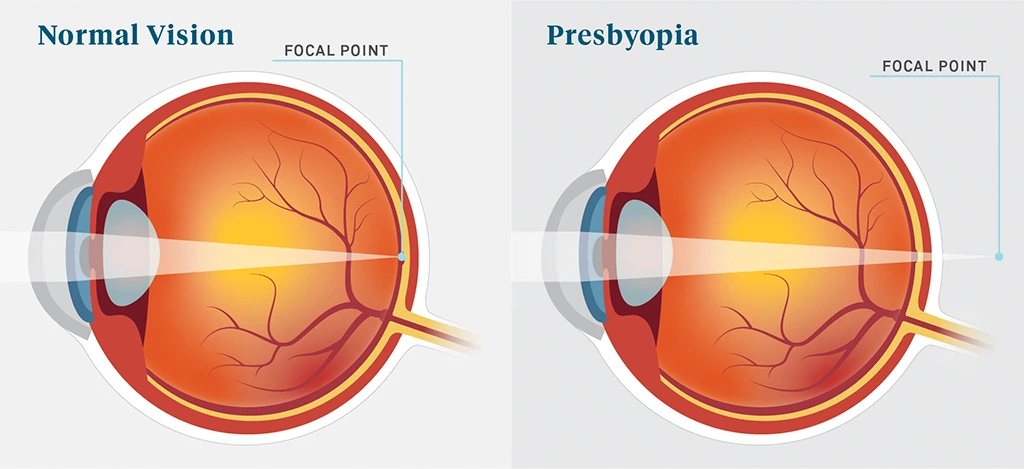
#LIVE2.0 #Review
When your eye naturally loses its ability to focus on nearby objects, the condition is generally referred as ‘Presbyopia’, often owed to natural aging process. In most cases, patients start noticing the symptoms of this eye condition through early to mid 40s, which continue to worsen until about 65 years of age.
Most people get aware of presbyopia when they start holding reading material like newspapers and books at arm’s length to be able to read them. It can be confirmed through a basic eye exam. Eyeglasses or contact lenses prove most helpful in correcting the condition, but surgery can also be considered according to the condition of the sufferer.
To understand better about presbyopia causes, you first need to understand how the eye functions at a very basic level.
The formation of an image in your eye involves the lens and the cornea focusing the light rays (reflected from the objects) on the retina at the back of your eye at a precise angle. This means that the lens flexes more when you zoom in on an object closer by.
Let’s recap these commonly used terms to make things even clearer:
Both of these structures coordinate together to bend or refract the light rays entering your eye, helping them focus the image on the retina.
The lens bears some flexibility as compared to the cornea; so, its shape can be changed with the help of a circular muscle surrounding it. The circular muscle relaxes while you look at something far away; whereas it constricts when you look at something nearby, enabling the relatively flexible lens to curve, changing its focusing power.
When the affects of increasing age harden the lens inside your eye, presbyopia is caused. Lessened flexibility of the lens means reduced ability to change shape and better focus close-up images.
This eye condition undergoes gradual development and the initial signs and symptoms might begin to appear when you are in your 40s. Some of those include:
The diagnosis of presbyopia is carried out by means of a basic eye exam, which includes refraction assessment of your eyes along with overall eye health evaluation.
Refraction assessment helps determine whether you are suffering from nearsightedness or farsightedness, presbyopia or astigmatism. This may involve using various instruments where your doctor requires you to look through several lenses to assess how well your distance vision and up-close vision is.
Sometimes, your eye doctor might resort to eye drops for diluting your pupils, which can increase the light sensitivity level of your eyes for a few hours. This enables your eye doctor a better view inside your eyes.
Presbyopia treatment aims at compensating for your eyes’ inability to focus rightly on nearby objects. Some major treatment options include the use of corrective eyeglasses, contact lenses, refractive surgery or presbyopia lens implants.
Irrespective of the type of the eyeglasses you choose for presbyopia treatment, it is highly advisable to consider lenses offering anti-reflective coating. This can help you deal with the issue of unwanted reflections, which are not only distracting while viewing something, but also cause eyestrain. Moreover, you encounter less glare and get increased visual clarity for driving at night.
Multifocal contact lenses can also help the victims of presbyopia, available as gas permeable or soft lens materials. ‘Monovision’ lenses are just another type of contact lenses designed to help people with presbyopia, whereby one eye is prescribed with a distance vision lens, while the other eye wears a lens for near vision. Your brain is intelligent enough to learn which eye to favor for the specific kind of task.
If you don’t feel comfortable wearing eyeglasses or contact lenses for treating your presbyopia, you may also resort to various surgical options for treatment.
‘Corneal Inlay’ is a surgical correction procedure, which is being prescribed by an increasing number of eye doctors. It is designed to increase depth of focus in the treated eye, compensating for reading glasses without significantly affecting the way your distance vision performs. Typically, it is implanted in the cornea of your non-dominant eye.
Like many other ways your body functions start deteriorating as a natural part of aging, presbyopia is also a natural inevitability and most of us are highly likely to deal with it after we hit 40s. Whether you choose eyeglasses, contact lenses or surgery, you’ll be able to do things like reading your favorite books, responding to text messages over your phone and so forth.
Just make sure to take good care of your eyes and adopt a healthier lifestyle, so that your eyes, just like your other bodily functions, remain healthy and active for as long as possible. Also, realize the significance of timely eye exams. The sooner your doctor is able to identify any irregularity in your eyes and vision, the higher will be your chances to get over with it and retain your independent lifestyle.
Support
See and Connect Today!
IrisVision Global, Inc.
5994 W. Las Positas Blvd, Suite 101
Pleasanton, CA 94588
Email: [email protected]
Support: +1 855 207 6665
Support
See and Connect Today!
IrisVision Global, Inc.
5994 W. Las Positas Blvd, Suite 101
Pleasanton, CA 94588
USA Email: [email protected]
Support: +1 855 207 6665
Support
See and Connect Today!
IrisVision Global, Inc.
5994 W. Las Positas Blvd, Suite 101
Pleasanton, CA 94588
Email: [email protected]
Support: +1 855 207 6665